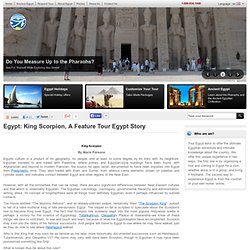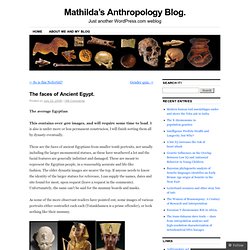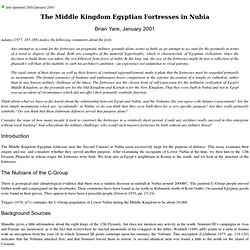

Index. NOVA Online/Pyramids—The Inside Story. WebTour. Archive for 'Archaeology' Famous archaeologists of the 20th century Archaeology has been romanticized in the movies, but even though it is a field that offers a lot less adrenaline rush in real life, it still attracts a lot of brilliant minds. They get a different kind of rush from the archaeological work that they do especially when on the field. If you are interested in this field then you might want to know some of the more famous names connected with it.
Here are some of the more famous archaeologists of the 20th Century: Leakey Family- This is a family of scientists now based in Kenya. Late Predynastic and Early Dynastic Egypt by Francesco Raffaele. Untitled. King Scorpion, A Feature Tour Egypt Story. By Marie Parsons Egypts culture is a product of its geography, its people, and at least to some degree by its links with its neighbors.

Egyptian traveled to and traded with Palestine, where pottery and Egyptian-style buildings have been found, with Afghanistan and beyond to modern Pakistan, the source for lapis lazuli, documented to have been imported into Egypt from Predynastic time. They also traded with Elam and Sumer, from whence came elements shown on palettes and cylinder seals, and indicates contact between Egypt and other regions of the Near East. However, with all the similarities that can be noted, there are also significant differences between Near Eastern cultures and that which is undeniably Egyptian. The Egyptian cosmology, cosmogony, governmental hierarchy and administration, writing, dress, its concept of kingshipthese were all things most definitely Egyptian, even if perhaps influenced by outside contacts. What is known thus far about this ruler? Sources: Archives. History of the Karnak Temple complex. The Pyramids of Egypt. Anthropology Department: Dongola Reach Expedition.
The Ancient Egypt Site - The Narmer Palette. Ch7. Fig. 27.

The Second Cataract Forts Fig. 28. Egyptian Photography and Reference Library. The Pyramids of Egypt. Battle of Kadesh: The Battle of Kadesh (Qadesh), Part II. Saqqara.nl Homepage. New Kingdom. The New Kingdom of Egypt, also referred to as the Egyptian Empire, is the period in ancient Egyptian history between the 16th century BC and the 11th century BC, covering the Eighteenth, Nineteenth, and Twentieth Dynasties of Egypt.

Radiocarbon dating places the exact beginning of the New Kingdom between 1570–1544 BC.[1] The New Kingdom followed the Second Intermediate Period and was succeeded by the Third Intermediate Period. It was Egypt’s most prosperous time and marked the peak of its power.[2] Mathilda’s Anthropology Blog. The average Egyptian This contains over 400 images, and will require some time to load.

It is also is under more or less permanent construcion, I will finish sorting them all by dynasty eventually. These are the faces of ancient Egyptians from smaller tomb portraits, not usually including the larger monumental statues, as these have weathered a lot and the facial features are generally indistinct and damaged. These are meant to represent the Egyptian people, in a reasonably accurate and life-like fashion. The older dynastic images are nearer the top.
As some of the more observant readers have pointed out, some images of various portraits either contradict each each (Tutankhamen is a prime offender), or look nothing like their mummy. Tutankamun’s many faces. Tiye. Home of The Virtual Egyptian Museum - King Padibastet's Tomb. Absolute Egyptology - Egypt before the Pharaohs. Digital Egypt for Universities. Hu, Diospolis Parva. Djoser Complex. ANCIENT EGYPT - History & Chronology. Theban Mapping Project. _Q. QADESH: battle of AKA Kadesh, Kaddesh, AKA En-mishpat.

The Old Testament refers to En-mishpat. Mishpat is Hebrew for Judgement. Battle of Kadesh ~1300 BCE? (as per K. [W_059,rvw] WATSON# "Centre de documentation et d'etudes sur l'histoire de l'art et de la civilisation de l'ancienne Egypte, [1964? This text refers to the stele du mariage, La bataille de Qadesh, and Graffiti anciens sur les colosses, [Memnon]. [W_060,rvw] WATSON# 533.5 H27, "Le poeme dit de Pentaour : et le rapport officiel sur la bataille de Qadesh / par Selim Hassan. " See Genesis: 14.7; En-mishpat (as per S. Murnane, W. (as per EEF; M. "Miserable is your courage, my chariot-fighters. See P. QANTIR: (AE) town See 2003 discovery of fragment of cuneiform archive of Ramses II.
(as per EEF; M. QUARRY: (Ancient and Modern) resources See various QUARRIES at various WADI. QUIPU: (Mayan/Incan) accounting See UHN: P. 542-3: re [Incan] QUIPU see Japanese Ketsujo of similar construct from Ryu-Kyu Islands. See Knot=[Arabic] “aqd od uqda” [not? Hatshepsut. For other ancient Egyptians called Maatkare, see Maatkare.

Hatshepsut (/hætˈʃɛpsʊt/;[4] also Hatchepsut; meaning Foremost of Noble Ladies;[5] 1507–1458 BC) was the fifth pharaoh of the Eighteenth Dynasty of Egypt. She was the second historically confirmed female pharaoh, the first being Sobekneferu.[6] (Various other women may have also ruled as pharaohs regnant or at least regents before Hatshepsut, as early as Neithhotep around 1600 years prior.) The Middle Kingdom Egyptian Fortresses in Nubia. Last updated 28th January 2001.
